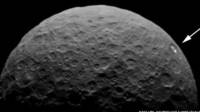- April 21, 2015
Share

The mysterious bright spots of the dwarf planet Ceres are back in sight.
The Dawn spacecraft, NASA, who came to this mini world 6 March, is now settled in its first orbit, about 13,500 kilometers of its surface.
The approach of the probe happened at the rear, on the night side, hiding the points system cameras and remote sensing instruments.
But each passing day, Dawn is seeing more terrain in the sun, now including its most enigmatic features.
The sequence of new images was taken a week ago when the probe was still about 22,000 . kilometers of the surface

However, clearly shows the brightest in the dark landscape point.
The team of the mission of the US space agency has not yet You named your location, referring to it simply as Region or point five.
No one knows for sure why the points reflect sunlight that way compared to their surroundings. It refers to the presence of ice, but the ice would not be stable in a body without atmosphere.
Another suggestion are salts, perhaps left behind after the ice has evaporated.

What’s intriguing is that not all the bright spots of Ceres have the same nature. Another point located, known as Region 1, is much cooler than the surrounding terrain. Region 5 does not show such behavior
Chris Russell, Dawn’s principal investigator, told the BBC last week. “It may be the surface composition, wherein the different material from that particular point conduct heat differently to other area manner, “he said.
” So the first thing you think of is that when you see different temperatures is that there will be a different thermal conductivity of the surface material. ”
Dawn conducted an intensive observation campaign starting this week and will be available in early May. Scientists should then be able to say something more precise about Ceres and fascinating points.
No comments:
Post a Comment